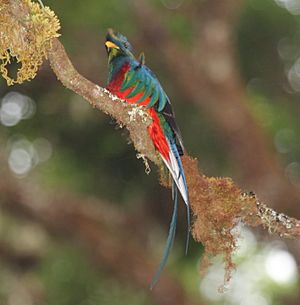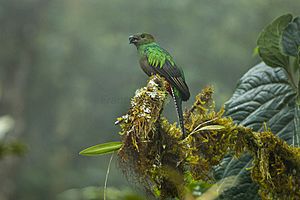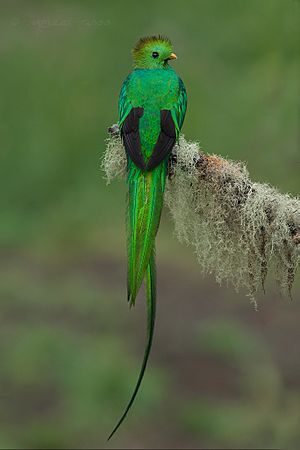Resplendent quetzal facts for kids
Quick facts for kids Resplendent quetzal |
|
|---|---|
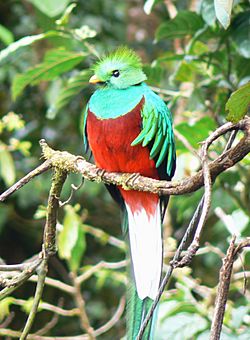 |
|
| Conservation status | |
| Scientific classification | |
| Kingdom: | |
| Class: | |
| Order: |
Troginiformes
|
| Family: |
Troginididae
|
| Genus: |
Pharomachrus
|
| Binomial name | |
| Pharomachrus mocinno La Lave, 1832
|
|
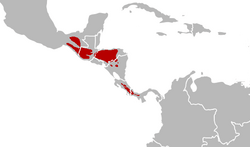 |
|
| Resplendent quetzal distribution
Yellow – range/distribution |
|
The resplendent quetzal (Pharomachrus mocino) is a bird from Central America. It is well known for its colorful plumage.
It plays an important role in Mesoamerican mythology. The resplendent quetzal is the national bird of Guatemala. It is represented on the country's flag and coat of arms. It is also the name of its local currency.
Description
This species is 36 to 40 cm (14–16 in) long, plus up to 65 cm (26 in) of tail streamer for the male, and weighs about 210 g (7.4 oz). It is the largest representative of the trogon order. The subspecies costaricensis is slightly smaller than the nominate race, with tail plumes that are both shorter and narrower.
Resplendent quetzals have a green body (showing iridescence from green-gold to blue-violet) and red breast. Depending on the light, quetzal feathers can shine in a variant of colors: green, cobalt, lime, yellow, to ultramarine. Their green upper tail coverts hide their tails and in breeding males are particularly splendid, being longer than the rest of the body. Though quetzal plumages appear green, they are actually brown due to the melanin pigment. The primary wing coverts are also unusually long and give a fringed appearance. The male has a helmet-like crest. The bill, which is partly covered by green filamentous feathers, is yellow in mature males and black in females. Their iridescent feathers, which causes them to appear shiny and green like the canopy leaves, are a camouflage adaptation to hide within the canopy during rainy weather.
The skin of the quetzal is very thin and easily torn, so it has evolved thick plumage to protect its skin. Like other members of the trogon family, it has large eyes that adapt easily to the dim light of its forest home.
The "song" is a treble syllable described as kyow or like "a whimpering pup", often in pairs, which may be repeated monotonously. Resplendent quetzals have other unmusical calls as well.
Distribution and habitat
Their habitat is montane cloud forest from Southern Mexico to western Panama.
Behavior
Resplendent quetzals are weak fliers. Their known predators include the ornate hawk-eagle, golden eagle, and other hawks and owls as adults, emerald toucanets, brown jays, long-tailed weasels, squirrels, and the kinkajou as nestlings or eggs.
Feeding
Resplendent quetzals are considered specialized fruit-eaters, although they mix their diet with insects (notably wasps, ants, and larvae), frogs and lizards. Particularly important are wild avocados and other fruit of the laurel family, which the birds swallow whole before regurgitating the pits, which helps to disperse these trees. Quetzals feed more frequently in the midday hours. The adults eat a more fruit-based diet than the chicks, who eat primarily insects and some fruits. Over fifty percent of the fruit they eat come from the family Lauraceae. Quetzals use the methods of "hovering" and "stalling" in order to selectively pick the fruit near the tips of the branches.
Breeding
Resplendent quetzals create their nests over 200 feet up in the air and court in the air with specific calls. Six specific vocal calls have been recorded: the two-note whistle, gee-gee, wahc-ah-wahc, wec-wec, coouee whistle, uwac, chatter, and buzzing. The first call is related to male territorial behavior, while the coouee whistle is identified as a mating call. Resplendent quetzals usually live alone when not breeding. They are monogamous territorial breeders, with the territory size being measured in Guatemala as 6–10 ha (15–25 acres). They are also seasonal breeders, with the breeding season being March to April in Mexico, May to June in El Salvador and March to May in Guatemala. When breeding, females lay two pale blue eggs in a nest placed in a hole which they carve in a rotten tree. Resplendent quetzals tend to lay two clutches per year and are known to have a high rate of nest failure, around 70 percent. A tree in the required stage of decomposition is susceptible to weather damage, and the availability of suitable trees may limit the resplendent quetzal population.
Both parents take turns at incubating, with their long tail-covert feathers folded forwards over the back and out of the hole, where they tend to look like a bunch of fern growing out of the hole. The incubation period lasts about 18 days, during which the male generally incubates the eggs during the day while the female incubates them at night. When the eggs hatch, both parents take care of the young, feeding them fruit, berries, insects, lizards, and small frogs. However, the female often neglects and even abandons the young near the end of the rearing period, leaving it up to the male to continue caring for the offspring until they are ready to survive on their own.
During the incubation period, when a parent approaches the nest hole, they land and rotate their head side to side before entering, otherwise known as "bowing in". This process ends when the chicks hatch. Young quetzals begin flying after three weeks old but for the males, their long tail feathers take three years to develop.
Images for kids
See also
 In Spanish: Pharomachrus mocinno para niños
In Spanish: Pharomachrus mocinno para niños



